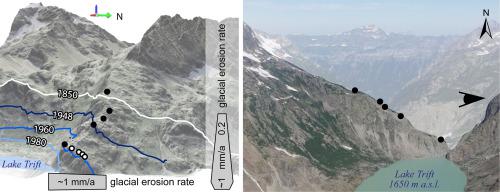当前位置:
X-MOL 学术
›
Geomorphology
›
论文详情
Our official English website, www.x-mol.net, welcomes your
feedback! (Note: you will need to create a separate account there.)
Glacial erosion by the Trift glacier (Switzerland): deciphering the development of riegels, rock basins and gorges
Geomorphology ( IF 3.1 ) Pub Date : 2021-02-01 , DOI: 10.1016/j.geomorph.2020.107533 Olivia Steinemann , Susan Ivy-Ochs , Kristina Hippe , Marcus Christl , Negar Haghipour , Hans-Arno Synal
Geomorphology ( IF 3.1 ) Pub Date : 2021-02-01 , DOI: 10.1016/j.geomorph.2020.107533 Olivia Steinemann , Susan Ivy-Ochs , Kristina Hippe , Marcus Christl , Negar Haghipour , Hans-Arno Synal

|
Abstract A long-lasting question in glacial geology is how and how fast glaciers were able to shape the distinctive landscapes of the Alps. This study contributes to the understanding on the formation of overdeepened basins, especially the processes and the amount of time involved. We examine the remarkably high (150 m) cross-valley bedrock riegel and the associated overdeepening located in front of the Trift glacier in the central Swiss Alps. A combined approach of field survey with measurements of two cosmogenic nuclides, 10Be and in-situ 14C, and a numerical model was used to determine the spatial glacial erosion patterns on the bedrock riegel. Ten samples were taken along two transects; one perpendicular to the glacier flow direction, from outside of the Little Ice Age (LIA) extent down to the centre of the riegel, and the other following the former ice-flow direction across the riegel. Analysis of measured nuclide concentrations shows that the sample outside of the LIA was constantly exposed since the retreat of the Egesen stadial Trift glacier (~11.5 ka). The samples inside the LIA extent indicate a distinct trend of increasing glacial erosion rates from 0 mm/a near the LIA ice margin to high erosion all across the top of the riegel. The resulting minimum glacial erosion rates from samples on the riegel are 0.5–1.1 mm/a (10Be) and 0.6–>1.8 mm/a (in-situ 14C) which correspond to minimum erosion depths of 1.6–>3 m (10Be) and 1–>5 m (14C). The extremely low nuclide concentrations measured at the riegel highlight the substantial erosion (predominantly abrasion) of the bedrock surface during late Holocene glacier coverage. Field observations suggest that the formation of the overdeepening and, as a consequence, the riegel is due to a combination of valley shape, bedrock structures, glacier confluence and hydrology. We further hypothesise that the gorge is a key factor responsible for this impressive overdeepening, by lowering the threshold for the subglacial meltwater, effectively decoupling the height of the riegel from the depth of the overdeepening.
中文翻译:

特里夫特冰川(瑞士)的冰川侵蚀:解读里格尔斯、岩石盆地和峡谷的发展
摘要 冰川地质学中一个长期存在的问题是冰川如何以及以多快的速度塑造了阿尔卑斯山的独特景观。这项研究有助于了解过深盆地的形成,特别是所涉及的过程和时间。我们检查了位于瑞士阿尔卑斯山中部特里夫特冰川前的非常高 (150 m) 的跨谷基岩 riegel 和相关的过度加深。现场调查与测量两种宇宙成因核素 10Be 和原位 14C 的组合方法以及数值模型用于确定基岩 riegel 上的空间冰川侵蚀模式。沿两条横断面采集了 10 个样品;一个垂直于冰川流动方向,从小冰河时代 (LIA) 范围的外部向下到 riegel 的中心,另一个沿着前冰流方向穿过里格尔。对测量的核素浓度的分析表明,自 Egesen stadial Trift 冰川 (~11.5 ka) 退缩以来,LIA 外的样本不断暴露。LIA 范围内的样本表明冰川侵蚀速率从 LIA 冰缘附近的 0 mm/a 增加到整个 riegel 顶部的高度侵蚀的明显趋势。来自 riegel 样品的最小冰川侵蚀率为 0.5–1.1 mm/a (10Be) 和 0.6–>1.8 mm/a(原位 14C),对应于 1.6–>3 m (10Be) 的最小侵蚀深度和 1–>5 m (14C)。在 riegel 测得的极低的核素浓度突出了在全新世晚期冰川覆盖期间基岩表面的大量侵蚀(主要是磨损)。实地观察表明,过深的形成以及由此产生的 riegel 是由于山谷形状、基岩结构、冰川汇合和水文的综合作用。我们进一步假设峡谷是造成这种令人印象深刻的过度加深的关键因素,通过降低冰下融水的阈值,有效地将 riegel 的高度与过度加深的深度脱钩。
更新日期:2021-02-01
中文翻译:

特里夫特冰川(瑞士)的冰川侵蚀:解读里格尔斯、岩石盆地和峡谷的发展
摘要 冰川地质学中一个长期存在的问题是冰川如何以及以多快的速度塑造了阿尔卑斯山的独特景观。这项研究有助于了解过深盆地的形成,特别是所涉及的过程和时间。我们检查了位于瑞士阿尔卑斯山中部特里夫特冰川前的非常高 (150 m) 的跨谷基岩 riegel 和相关的过度加深。现场调查与测量两种宇宙成因核素 10Be 和原位 14C 的组合方法以及数值模型用于确定基岩 riegel 上的空间冰川侵蚀模式。沿两条横断面采集了 10 个样品;一个垂直于冰川流动方向,从小冰河时代 (LIA) 范围的外部向下到 riegel 的中心,另一个沿着前冰流方向穿过里格尔。对测量的核素浓度的分析表明,自 Egesen stadial Trift 冰川 (~11.5 ka) 退缩以来,LIA 外的样本不断暴露。LIA 范围内的样本表明冰川侵蚀速率从 LIA 冰缘附近的 0 mm/a 增加到整个 riegel 顶部的高度侵蚀的明显趋势。来自 riegel 样品的最小冰川侵蚀率为 0.5–1.1 mm/a (10Be) 和 0.6–>1.8 mm/a(原位 14C),对应于 1.6–>3 m (10Be) 的最小侵蚀深度和 1–>5 m (14C)。在 riegel 测得的极低的核素浓度突出了在全新世晚期冰川覆盖期间基岩表面的大量侵蚀(主要是磨损)。实地观察表明,过深的形成以及由此产生的 riegel 是由于山谷形状、基岩结构、冰川汇合和水文的综合作用。我们进一步假设峡谷是造成这种令人印象深刻的过度加深的关键因素,通过降低冰下融水的阈值,有效地将 riegel 的高度与过度加深的深度脱钩。











































 京公网安备 11010802027423号
京公网安备 11010802027423号